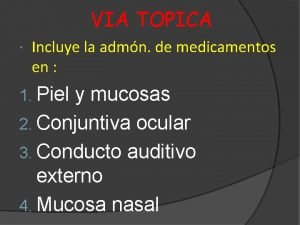Vital SignsTemperature Auraltympanic and Rectal Health Sciences 2














- Slides: 14

Vital Signs-Temperature Aural/tympanic and Rectal Health Sciences 2

The Basics of Aural Temperature �Also called tympanic temperature in reference to the eardrum (aka the tympanic membrane) �Thermometer detects and measures thermal, infrared energy radiating from the blood vessels in the eardrum �Measures body core temperature

Reasons for �Quick for infants and small children �When it is contraindicated for oral such as patient’s with limited consciousness or seizures

Contraindications �Ear canal misshapen �A lot of ear wax in canal �Active middle ear infection �Sore ear �Recent ear surgery

Type of Thermometer • Hand held temperature probe with disposable tip cover. • Digital recording and reading • Thermometer beeps usually within 2 seconds.

Measuring Aural Temperature � Infants under 1 year �Pull ear pinna straight back � Infants over 1 year and adults �Pull ear pinna straight back and down � Positioning the pinna correctly straightens the auditory canal so the probe will point directly at the tympanic membrane �Pull ear pinna straight back and down

Taking Aural Temperature

Basics of Rectal Temperature �Can use either clinical or electronic thermometer �It is an internal measurement �It is the most accurate �Frequently taken on infants and small children

Reasons for Taking Rectal Temperature � The rectal procedure is normally used for an infant or young child � It can also be used for a patient who is unconscious or irrational � If your patient has difficulty breathing with his mouth closed, you could use rectal � The rectal route is used in the case of any suspected environmental injury such as heatstroke or hypothermia.

Contraindications for Rectal Temperature � If the patient has a heart condition; you can stimulate the Vagus nerve and cause cardiac arrythmias � If the patient has hemorrhoids; its an enlarged vein and you can cause bleeding and pain as a result � If the patient has recently under gone rectal, anal, vaginal, or prostate surgery. � If the patient has diarrhea; you can stimulate bowel movement � If the patient has fecal impaction (you can record incorrect temperature) � If the patient has bleeding tendencies from medications such as heparin or low platelets � And age related contraindications; if patient over 80 years old

Types of Thermometers �Electronic �Can be used for oral, rectal, or axillary �Blue probe for oral �Red probe for rectal RED=RECTAL �Disposable probe covers prevent crosscontamination

Types of Thermometer � Clinical thermometers �Slender glass tube containing mercury or colored fluid �Types �Oral – blue tip, long slender bulb, marked oral �Security – plain tip �Rectal – red tip, short stubby bulb, marked rectal

Measuring Rectal Temperature �Follow standard precautions/wash hands and glove �Have thermometer, probe cover, and lubricant �If adult, place patient on left side in Sim’s position �If infant, place on abdomen or lay on their back with legs secured �Use lubricant on tip of thermometer and gently insert 1 -1 ½ inches into the rectum for adult and ½-1 inch into rectum for infant �Hold in place for 3 -5 minutes �Do not let go of thermometer-it can slide in further or break

Procedure 15: 2 C Please refer to DHO pages 423 -424 for complete and proper procedure of measuring rectal temperature. Infant Adult
 Pet 3351 ucf
Pet 3351 ucf Human sciences tok
Human sciences tok Capacidad vital y capacidad vital forzada
Capacidad vital y capacidad vital forzada Axillary temperature
Axillary temperature Pulse points of the body
Pulse points of the body Types of suppository bases
Types of suppository bases Where is the left gastric artery
Where is the left gastric artery Origin of sma
Origin of sma Via de administracion sublingual
Via de administracion sublingual Syndrome rectal de bensaude
Syndrome rectal de bensaude Presentación cefotaxima
Presentación cefotaxima Medicamento via nasal
Medicamento via nasal Similar
Similar Rectal rocket compound
Rectal rocket compound Oral rehydration solution composition
Oral rehydration solution composition



























